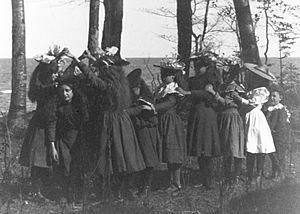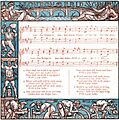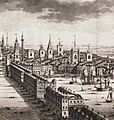London Bridge Is Falling Down facts for kids
"London Bridge Is Falling Down" is a very old and popular nursery rhyme and singing game. You can find different versions of it all around the world! The song is about the famous London Bridge having problems and people trying to fix it.
This rhyme might be from bridge songs and games played a long, long time ago, even in the Middle Ages. But we first saw the words written down in English in the 1600s. The lyrics we know today were first printed in the mid-1700s and became very popular, especially in Britain and the United States, in the 1800s. The tune we sing today was first written down in the late 1800s. The game itself is like old "arch games" from the Middle Ages, but it became popular in its current form in the late 1800s. This song has a special number in a list of folk songs, which is 502. People have many ideas about what the rhyme means and who the "fair lady" in the song might be. It's one of the most famous rhymes in the world and has appeared in many books, movies, and TV shows.
Lyrics of the Song
There are many different ways people sing the words to this rhyme. The most common first part is:
London Bridge is falling down,
Falling down, falling down.
London Bridge is falling down,
My fair lady.
In a longer version shared by Iona and Peter Opie in 1951, the full song goes like this:
London Bridge is broken down,
Broken down, broken down.
London Bridge is broken down,
My fair lady.
Build it up with wood and clay,
Wood and clay, wood and clay,
Build it up with wood and clay,
My fair lady.
Wood and clay will wash away,
Wash away, wash away,
Wood and clay will wash away,
My fair lady.
Build it up with bricks and mortar,
Bricks and mortar, bricks and mortar,
Build it up with bricks and mortar,
My fair lady.
Bricks and mortar will not stay,
Will not stay, will not stay,
Bricks and mortar will not stay,
My fair lady.
Build it up with iron and steel,
Iron and steel, iron and steel,
Build it up with iron and steel,
My fair lady.
Iron and steel will bend and bow,
Bend and bow, bend and bow,
Iron and steel will bend and bow,
My fair lady.
Build it up with silver and gold,
Silver and gold, silver and gold,
Build it up with silver and gold,
My fair lady.
Silver and gold will be stolen away,
Stolen away, stolen away,
Silver and gold will be stolen away,
My fair lady.
Set a man to watch all night,
Watch all night, watch all night,
Set a man to watch all night,
My fair lady.
Suppose the man should fall asleep,
Fall asleep, fall asleep,
Suppose the man should fall asleep?
My fair lady.
Give him a pipe to smoke all night,
Smoke all night, smoke all night,
Give him a pipe to smoke all night,
My fair lady.
This rhyme is made up of groups of four lines. Each line has a special rhythm that is common in nursery rhymes. It often repeats words instead of using rhyming words, which is a trick often used in children's songs and stories.
How to Play the Game
The rhyme is often used in a fun children's singing game. There are many ways to play it, sometimes with extra verses. Most versions are similar to the game played with the rhyme "Oranges and Lemons".
The most common way to play is for two players to make an arch by holding hands high. The other players then walk or run through this arch in a single line. When the song ends, the two players forming the arch quickly lower their arms to "catch" a player. In the United States, it's common for the caught players to form two teams and have a tug of war.
In England, until the 1800s, the song might have been played with a circle dance. But arch games have been popular across Europe since the Middle Ages. Some versions of the game from the late 1800s mention a prisoner who stole a watch and chain. This part might have come from another game called "Hark the Robbers." This other rhyme is sung to the same tune and might be connected to "London Bridge" or be a separate game. In one version, the first two parts of this "prisoner" game go like this:
Who has stole my watch and chain,
Watch and chain, watch and chain;
Who has stole my watch and chain,
My fair lady?
Off to prison you must go,
You must go, you must go;
Off to prison you must go,
My fair lady.
Images for kids
-
Illustration from Walter Crane's A Baby's Bouquet (around 1877)
-
Canute the Great's men on London Bridge, being attacked by Olaf II of Norway, from an 1894 children's book.
See also
 In Spanish: London Bridge Is Falling Down para niños
In Spanish: London Bridge Is Falling Down para niños










